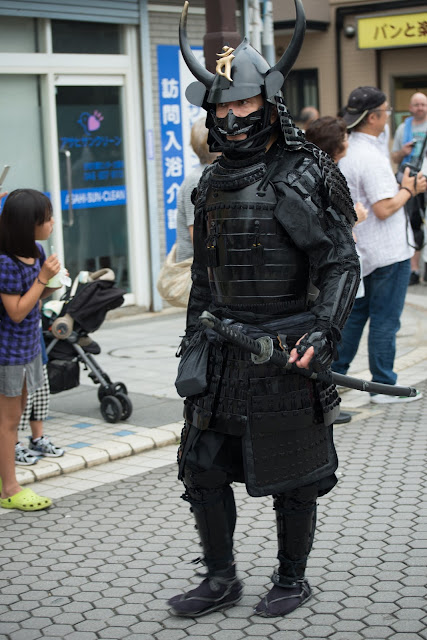Kurihama Perry Festival - marking 160 years since the arrival of the Black Ships
Today I saw the parade in Kurihama which is part of the Kurihama Perry Festival. It re-enacts by way of parade floats the arrival of the black ships (kurofune in Japanese).
According to Wikipedia "Kurofune refers to Mississippi, Plymouth, Saratoga, and Susquehanna, that arrived on July 14, 1853 at Uraga Harbor (part of present-day Yokosuka) in Kanagawa Prefecture, Japan under the command of United States Commodore Matthew Perry. Black refers to the black color of the older sailing vessels, and the black smoke from the coal-fired power plants of the American ships. In this sense, the Kurofune became a symbol of the ending of isolation.
The parade was very enjoyable to watch, the mix of bands, floats to represent the ships, baton twirlers and various other dance teams reminded me of the annual carnival parades back in my hometown in the UK that I used to participate in as a child.
Leading the parade these very earnest flag twirling girls...
There were some representatives of the Navy, ok I have no idea who the people are but they seemed to be enjoying the day...
A group from one of the local schools playing, of all things "When the saints go marching in" or at least that's what I know it as. The boy on the cymbols didn't look very happy to be there.
Then came the floats representing the Black Ships
The next band were leading the float representing Commodore Perry's Black Ship. For some reason they were playing Abba's "Dancing Queen".
I'm sure this is exactly how the first meeting looked in July 1853...
Conch-shell playing seemed to be an important part of the parade
I loved this young boy who was doing an impressive job wielding his sword. And bearing in mind the temperature was in the low 30s, this made it even more impressive...
And in the heat, the cool composure of this lady caught my eye.
Coming of the Black Ships, if they met this guy when they landed, I imagine that would have been a bit scary although I suppose they did have their military ships with them.
I love the groups of younger children performing in bands and dance groups. Some participants like the young lady at the front of the band pictured below seemed to be enjoying herself, but I'm not so sure about the boy with the orange on his hat to the right behind her, he seems a bit grumpy about it all.
For the very young ones, it all seemed to be too much... but they are very kawaii (cute)
This group had perhaps the best baton twirlers, and their leader was definitely in show mode
My three favourite groups came towards the end of the parade with more traditional Japanese dance styles and dress.
Doesn't matter about age, this lady keeping up with the best of them was eye-catching to me.
And as they passed, I caught this lady, as her ribbons were flying and she looks great.
Again, showing age is no barrier to enthusiasm, this group's costume was very vibrant and they performed with gusto!
The final group in the parade were very beautiful, in identical kimono with bright yellow headscarfs and very nicely synchronised movement.
Although it was a hot day, it was great to observe this renactment of the time when Japan, after a period of self imposed isolation, re-joined the world stage and to see young and old participating in the parade.








































